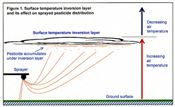Surface Temperature Inversions And Spray Drift
DR. LEE TOWNSEND
LEXINGTON, KY.
Usually, when the sun’s energy hits the ground, it warms the air at the surface. This warm air normally expands and cools as it rises, so air temperature decreases with altitude.
A temperature inversion occurs when a layer of cool air is trapped below warmer air. If pesticides are sprayed during an inversion, spray particles or vapor stay in the cooler air and do not disperse normally (Figure 1). It is unsafe to spray when conditions favor surface temperature inversions.
A surface temperature inversion is likely to be present if:
• Mist, fog, dew, or a frost have occurred.
• Smoke or dust hangs in the air and moves sideways, just above the surface.
• Cumulus clouds that have built up during the day collapse towards evening.
• There is a large difference between the observed maximum and overnight minimum temperatures.
• Wind speed is constantly less than 11 kilometers (6.8 miles) per hour in the evening and overnight
• Cool, off-slope breezes develop during evening or overnight.
• Distant sounds become easier to hear.
• Aromas are more distinct during the evening than during the day. ∆
DR. LEE TOWNSEND: Extension Entomologist, University of Kentucky

Figure 1. Surface temperature inversion layer and its effect on sprayed pesticide distribution
(Source: http://agriculture.vic.gov.au/__data/assets/image/0007/244249/Inversion-diagram096.gif)